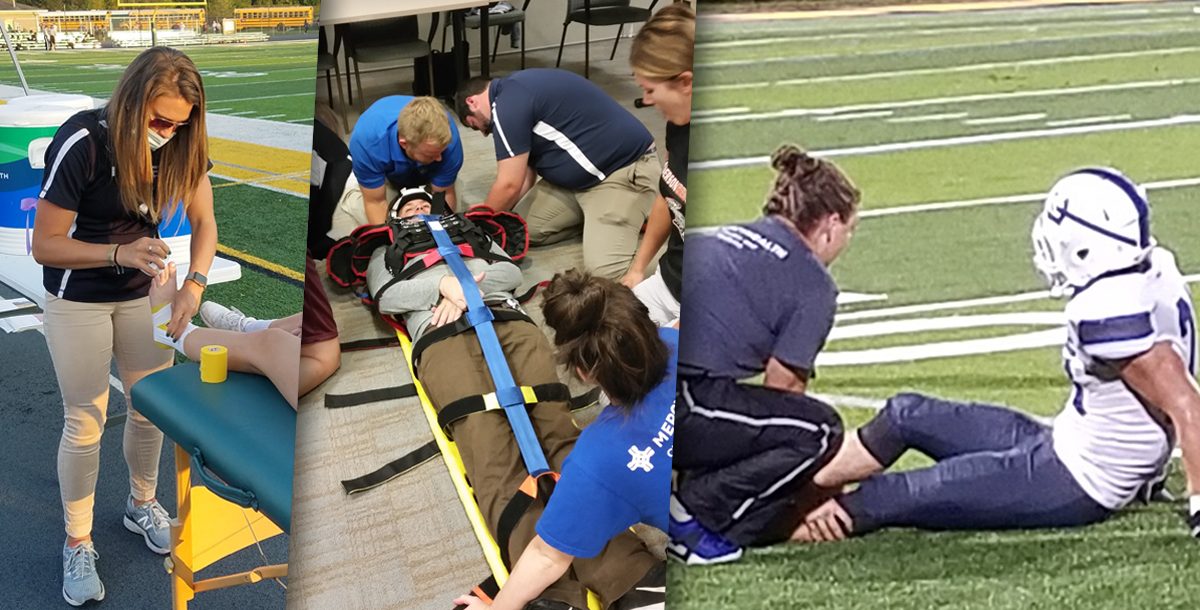Lisa Sweeterman, MHA, M.Ed, AT, is the director of sports medicine partnerships and TQL Stadium medical services in our Cincinnati market. In honor of Athletic Training Month, Lisa sat down with us to answer a few questions about the profession.
What is the role of an athletic trainer?
Athletic trainers manage the health care needs of an athlete or active person. So, when you are watching a game in person or on TV and a player is injured, the athletic trainer is the person running onto the field to manage that situation. Athletic trainers are also the first responders to most injuries or emergency situations of an athlete. They are responsible for the recognition of that issue as well as the management and treatment.
Behind the scenes, athletic trainers are managing prevention programs, running rehabilitation protocols for injured athletes, evaluating injuries and maintaining emergency action plans. We work closely with orthopedic physicians, primary care or various specialties including behavioral/mental health professionals to make sure athletes have access to the appropriate medical care needed for their situation. We are also communicating daily with coaches and family members on the status and needs of the athletes.
In many cases, athletes see their athletic trainer as their partner in staying healthy and in the game!
What is your level of education?
Athletic training is an entry-level master’s degree profession that usually includes a five-year degree with hands-on training. All athletic trainers must pass a national certified exam and most states have full state licensure. Athletic trainers are also required to maintain many hours of continuing education per year as well as professional level CPR/AED training. Many states now require mental health training and ethics training for athletic trainers as well.
At what venues will you find athletic trainers?
We can be found anywhere athletic or active participation is happening! While the most recognized areas of employment are professional sports, college athletic programs and high school athletic programs, athletic trainers can be found in hospitals, the armed forces, corporate workplaces and in areas of performing arts.
What is the role of an athletic trainer in emergency planning?
An athletic trainer develops an emergency action plan for each venue that they work in. This includes outlining the roles of each person in an emergency, how to activate EMS to their site, managing the injury or illness on field and maintaining a safe environment for all involved.
For example, if a football player goes down on the field with a broken leg, each person on site should know what their role is in managing this situation from the second that injury happens to the player arriving at the emergency room. Everyone has a role to play, and they are all managed by the athletic trainer on site.
Emergency action plans not only include gameday emergencies but what happens during a practice, in the weight room or athletic training room. A player spends most of their active time in practice or training, so an athletic trainer has to be prepared for the worst at all times, not just during the game.
What equipment does an athletic trainer need to do their job?
Athletic trainers carry kits that include the basics of wound care, tape for injury management as well as emergency supplies. Those emergency supplies can include an automated external defibrillator (AED), epi pens, inhalers, Narcan, backboards, neck braces, splints, glucose monitors and more depending on the sport or activity. And athletic trainers at professional football games include many different types of medical professionals and equipment than is required for the sidelines of, say, a tennis match or gymnastics meet. Basically, it all depends on the sport!
How exactly does an athletic trainer work with paramedics, physicians and other specialists?
As I shared before, an athletic trainer is usually the first responder in most injuries or illnesses. We evaluate the situation and make determinations for further care as needed.
If an athletic trainer feels the issue needs emergency care, EMS can be called or brought onto the field. We will then work with the medics to determine best plan of care and activate that plan. Athletic trainers work closely with orthopedic physicians on the management of orthopedic injuries. Should that athlete need further diagnostics, including an X-ray or MRI, the athletic trainers will work with the orthopedics on getting them the treatment and care that they need.
And should an athlete need surgery, athletic trainers work with the surgeons on provide prehabiliation and post-surgical rehabilitation of that athlete, including providing the training needed to return that athlete to the field in a safe and successful manner.
Why should all high schools and colleges have full-time athletic trainers?
In all athletics, whether it be a collision sport, like football, or a precision sport, like gymnastics, injuries and emergencies happen. Athletic trainers are highly skilled and educated to manage the range of injuries, illnesses and emergency care needed. With the athletic trainers on the sidelines of games and practices, that care is immediate. We have the skills to recognize not only a full range of orthopedic injuries, but we are also trained to manage even the most critical of emergency situations and provide the best care possible to the athletes.
Athletic trainers also work hard to prevent injuries, making sure equipment is up to date, fields are safe, weather conditions are safe and athletes are working at their best.
What should someone who wants to be an athletic trainer know before going into the profession?
Athletic training is a very rewarding but taxing profession. We are on site before athletes arrive and well after they leave. We are standing in the pouring rain or the exhausting heat of the afternoon. The hours are usually not nine to five, as we cover many events in the evenings and weekends.
It is also a physically demanding profession because you are often standing for most of your days on sidelines, rehabbing athletes in the training room or running onto the field to manage an injury. But you are on the front lines of keeping athletes healthy or getting them back to full strength to help make that game-winning shot! Athletic trainers are integral members of teams and their performance.
And finally, why did you decide to go into athletic training?
Like many athletic trainers, I was an athlete growing up and suffered a pretty significant injury in high school. My athletic trainer was integral in getting me back on the field. She did it with care, compassion and a great deal of knowledge of the human body and the mechanics needed to play my sport. I loved sports and being part of a team but I was not talented enough to play into college and beyond, so athletic training seemed like a good option.
Learn more about the sports medicine and orthopedics services we offer at Mercy Health.






